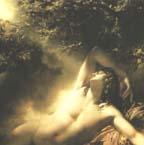Bluebell (Hyacinthoides
non scripta)
This perennial woodland flower is a native of Britain, where it is a
protected plant and where mass growth can indicate ancient woodland. It
has been cultivated since 1500 in Europe and has escaped into the wild
in the northeast of the US. This is a classic Fae plant. Some string
bluebell flowers on Beltane to
attract the Fae. Others believe that if you hear a bluebell ring, you
or someone close to you will die. In the UK bluebells are sometimes
found growing in a huge mass in the woods. It was thought unlucky to
cross through such a mass because it was full of Fae spells. Children
were especially considered to be vulnerable to being trapped in a
bluebell
glade by Fairy magick. Top
 At the same time, this is a Saturn plant often associated with death
and planted on graves as a comfort to those left behind. Another Latin
name for this plant is Endymion, for a shepherd boy with whom the Moon
goddess Selene (later identified with Diana) fell in love. She asked that he be granted eternal
life, and he was made to sleep forever. Selene visited his grave each
night to kiss him. He helped her bear 50 daughters. In this myth we can
see the idea of death's link to life and fertility. Perhaps because of
Endymion's eternal sleep, bluebells are said to help prevent nightmares
if kept near the sleeper or sewn into a dream pillow. Top
At the same time, this is a Saturn plant often associated with death
and planted on graves as a comfort to those left behind. Another Latin
name for this plant is Endymion, for a shepherd boy with whom the Moon
goddess Selene (later identified with Diana) fell in love. She asked that he be granted eternal
life, and he was made to sleep forever. Selene visited his grave each
night to kiss him. He helped her bear 50 daughters. In this myth we can
see the idea of death's link to life and fertility. Perhaps because of
Endymion's eternal sleep, bluebells are said to help prevent nightmares
if kept near the sleeper or sewn into a dream pillow. Top
In the language of flowers, bluebell represents humility, delicacy, and
constancy. In contrast, its flower essence is associated with Pan and helps one feel
joyful and spontaneous. Ruffs were stiffened with the starch of its
bulbs, and its sap was used to bind books, glue paper, and stick
feathers onto arrows. Although it is a folk cure for snakebite, the
plant is poisonous. Its dangerous chemicals are being researched as
treatments for cancers and infections from HIV. Bluebells are also known as
Auld Man's Bells, Calverkeys, Culverkeys,
English Bluebell, Jacinth, Ring-o'-Bells, Wilde Hyacint, Wood Bells,
crowtoes, crawtees, deadmen's bells, and cuckoo bells. Top
How to grow bluebells: This seed requires cold-moist stratification.
Fold into a paper towel that has been wet and wrung out. Put in a baggie in
the fridge for 4-6 weeks, then take out and sow. Or sow on Winter Solstice (see the Solstice Sowing
page). Some grow the seedlings in a pot the first year, fertilizing
regularly, and then plant in the ground their 2nd year when the leaves
are dormant. Bluebells like to grow in sunny woodlands/dappled shade
and in acidic
soil, but they do fine in clay and dry shade. They are good for
naturalizing under trees but can't grow in heavy shade or where they
will be walked on. Like marigolds, bluebells help combat nematodes in
the soil, and they also encourage a lot of helpful fungi. The blue
bell-like flowers have a light balsamic scent when they appear in
April-May. Once the plants develop bulbs, you can divide them each
summer when the leaves die back. Bluebells get 12-14"/25cm tall &
bloom in spring. They are a good perennial to zone 5 (temperate) =
-20F/-28C. They are good cut flowers and their seedpods are decorative. General growing info. Top
Uses in
Witchcraft & Magic:
Celebrating Beltane
Fairy Magic
Protection
Spells
Saturn Herb
© 2004, 2014 Harold A. Roth; No reproduction without permission